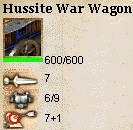No edit summary |
VelvetClaw (talk | contribs) |
||
| (5 intermediate revisions by one other user not shown) | |||
| Line 11: | Line 11: | ||
[[File:AOK073.jpg|thumb|left]] |
[[File:AOK073.jpg|thumb|left]] |
||
| − | |||
| − | |||
| Line 36: | Line 34: | ||
Garrison: 4 foot units (not inc. monks, peasants) |
Garrison: 4 foot units (not inc. monks, peasants) |
||
| − | Special: +2 vs. unique units, +4 vs. archers; +1 armour vs cavalry, +3 armour vs archers, +2 armour vs unique units |
+ | Special: +2 vs. unique units and War Cogs, +4 vs. archers; +1 armour vs anti-cavalry, +3 armour vs archers, +2 armour vs unique units and War Cogs |
| + | |||
===Upgrade=== |
===Upgrade=== |
||
Upgrade of: War Wagon |
Upgrade of: War Wagon |
||
| Line 42: | Line 41: | ||
Range: Siege Engineers |
Range: Siege Engineers |
||
| + | Training time: Indenture |
||
| ⚫ | |||
| + | |||
| ⚫ | |||
The Hussite War Wagon unit can be used in the same way as the weaker version. However, it profits from better stats and can carry 4 units that effectively increase its speed. Making combined use of the bonuses against unique units as well as archers, the Hussite War Wagon is definitely the best counter to the Welsh [[Saethwr]] and even more so against the [[Genoese Arbalester]]s and [[Genoese Guard|Guards]] that, unlike other crossbows, lack a better range. |
The Hussite War Wagon unit can be used in the same way as the weaker version. However, it profits from better stats and can carry 4 units that effectively increase its speed. Making combined use of the bonuses against unique units as well as archers, the Hussite War Wagon is definitely the best counter to the Welsh [[Saethwr]] and even more so against the [[Genoese Arbalester]]s and [[Genoese Guard|Guards]] that, unlike other crossbows, lack a better range. |
||
| + | ==Background Info== |
||
| + | Prior to the Hussite Wars, warfare often revolved around the deployment of cavalry and infantry in formation, and the Hussite general Jan Žižka realised that since the Hussite militia wasn't going to be effective against the knights of the Imperial armies, something had to be done in order to at least blunt the expected heavy cavalry assaults that were to take place. Instead of using pikemen, Žižka had his men deploy carts in combat which functioned as both transport and a portable fortification. Armed with crossbows and early firearms, the crews of the carts would first fire on the enemy cavalry, which more often than not charged into them with heavy losses. This was then followed by a counter-attack by the Hussite infantry which would mean that both armies would now be fighting on more equal terms. Although Žižka would meet his end by disease in 1424, and the Hussites were soon crushed and re-assimilated into mainstream Chrsitianity, the effectiveness of the Hussites' tactics (known as a ''Wagenburg'' or ''tabór'') would live on well in battlefields throughout Europe, Central Asia, North America and Africa for centuries to come. |
||
[[Category:Unique Units]] |
[[Category:Unique Units]] |
||
Latest revision as of 05:28, 14 September 2012
The Hussite War Wagon is the upgraded form of the War Wagon. It is stronger and better armoured, than the standard wagon and can carry 4 military foot soldiers.
Unit Statistics[]
Vital[]
Available to: Bohemia
Trained at: Castle
Century: 15th
Cost: 100 Wood, 80 Florins

Combat[]
HP: 600
Attack: 7
Armor/Pierce Armor: 6/9
Range: 7
Garrison: 4 foot units (not inc. monks, peasants)
Special: +2 vs. unique units and War Cogs, +4 vs. archers; +1 armour vs anti-cavalry, +3 armour vs archers, +2 armour vs unique units and War Cogs
Upgrade[]
Upgrade of: War Wagon
Range: Siege Engineers
Training time: Indenture
Commentary/Strategy[]
The Hussite War Wagon unit can be used in the same way as the weaker version. However, it profits from better stats and can carry 4 units that effectively increase its speed. Making combined use of the bonuses against unique units as well as archers, the Hussite War Wagon is definitely the best counter to the Welsh Saethwr and even more so against the Genoese Arbalesters and Guards that, unlike other crossbows, lack a better range.
Background Info[]
Prior to the Hussite Wars, warfare often revolved around the deployment of cavalry and infantry in formation, and the Hussite general Jan Žižka realised that since the Hussite militia wasn't going to be effective against the knights of the Imperial armies, something had to be done in order to at least blunt the expected heavy cavalry assaults that were to take place. Instead of using pikemen, Žižka had his men deploy carts in combat which functioned as both transport and a portable fortification. Armed with crossbows and early firearms, the crews of the carts would first fire on the enemy cavalry, which more often than not charged into them with heavy losses. This was then followed by a counter-attack by the Hussite infantry which would mean that both armies would now be fighting on more equal terms. Although Žižka would meet his end by disease in 1424, and the Hussites were soon crushed and re-assimilated into mainstream Chrsitianity, the effectiveness of the Hussites' tactics (known as a Wagenburg or tabór) would live on well in battlefields throughout Europe, Central Asia, North America and Africa for centuries to come.